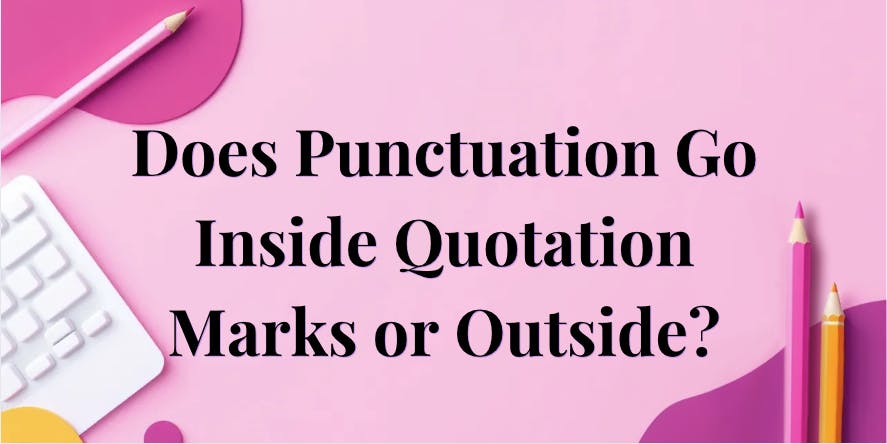Grammar and Punctuation
Does Punctuation Go Inside Quotation Marks or Outside?
By Ben Long

Punctuation and quotation marks can be confusing. American and British English follow different rules. So the answer to the question, “does punctuation go inside quotation marks or outside?” depends on which version of the language you speak.
In American English, periods and commas go inside quotation marks. In British English, they stay outside unless part of the quote.
These rules are important for clear and professional writing. Misplacing punctuation can make your writing harder to read.
This article explains when to put punctuation inside or outside quotation marks. It also answers questions like, “Do commas go inside quotes?” By learning these rules, you can make your writing clearer and more professional.
TL;DR:
- In American English, periods and commas always go inside quotation marks. In British English, they go outside unless part of the quote.
- Commas and periods go inside in American English but usually outside in British English. Question marks and exclamation points depend on meaning.
- Have a punctuation question about your document? Test it in our online grammar checker to spot and fix errors.
Does Punctuation Go Inside Quotation Marks Or Outside?
Punctuation placement with quotation marks can vary between American and British English.
In American English, periods and commas are always placed inside the quotation marks.
For instance: She said, "I'll be there soon."
In British English, periods and commas are typically placed outside unless they are part of the quoted material.
For example: She said, "I'll be there soon".
Other types of punctuation, such as question marks and exclamation points, depend on whether they pertain to the quoted material or the entire sentence.
In both American and British English, if the punctuation is relevant to the quoted text, it is placed inside the quotation marks. If it pertains to the main sentence, it is placed outside:
- American English: "Did you finish your homework?"
- British English: Did she ask, "Are you coming"?
Single Quotation Marks are often used for quotes within quotes. In such cases, punctuation follows the same rules.
For example: "She said, 'I'll call you later,' but she didn't," he complained.
Understanding these rules can clarify the correct presentation of direct quotes and dialogue in writing. This ensures that the intended meaning and flow are properly conveyed when using quotes and other quoted materials.
When To Use Punctuation Inside Quotation Marks
In American English, punctuation often goes inside quotation marks. Placing it outside punctuation is one of many common grammatical errors.
Common examples include commas and periods. These two elements are typically placed inside the end quotation marks, even if they are not part of the quoted material.
For instance:
- He said, "Let's meet after lunch."
- "Yes," she replied, "I will be there."
Question marks and exclamation points are used differently. They are placed inside quotation marks only when the punctuation is part of the quoted material. When they are not, they sit outside the marks:
- He asked, "Are we there yet?"
- Did she say, "We're leaving now"?
- She yelled, "Watch out!"
- You yelled, “What is punctuation”?
In British English, punctuation rules differ slightly.
Here, punctuation like commas and periods generally go outside unless part of the quotation. This distinction is important when writing for audiences familiar with different punctuation standards.
The placement of punctuation is essential for clarity and coherence. By following these guidelines, one ensures that written communication remains precise and consistent. For extra help, try checking your document with our online grammar checker.
When To Use Punctuation Outside Quotation Marks
In American English, punctuation like commas and periods usually goes inside quotation marks. But there are exceptions.
For example, semicolons and colons always stay outside. For instance: He said, "I'll try to finish"; this gave everyone hope. The semicolon is not part of the quote.
Question marks and exclamation points depend on context. If they apply to the whole sentence, they go outside. For example: Did she say, "We’ll meet later"?
British English follows a logical approach. Colons and semicolons stay outside. Periods and commas also stay outside unless they belong to the quote.
Some may ask, "How do you end a sentence with a quote?" or "Do quotes go after the period?"
The answer depends on the style. British English typically places punctuation outside, while American English keeps it inside.
Knowing when to place punctuation outside helps make writing clear. It shows where the quote ends and the writer’s words begin. Clear punctuation makes writing easier to read.
Key Takeaways on Punctuation Inside Quotation Marks
Punctuation and quotation marks follow different rules. American English puts commas and periods inside. British English keeps them outside unless part of the quote. Other marks, like question marks, depend on the sentence.
Clear punctuation makes writing easy to read. Tools like the Hemingway Editor can simplify these rules. They also help improve clarity and accuracy.
By following these guidelines, you can write clearly and professionally.